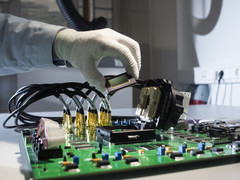The European Union's strategy to secure its own supply of microchips is "very out of touch with reality," according to a scathing report from the official European Court of Auditors. According to the auditors' calculations, the European market will not reach its target of supplying 20% of the world's microchips by 2030.
The European authorities have failed to implement the "Chip Law", now they need to edit the old strategy or write a new plan, writes The Guardian.
The European "Chip Act", designed to provide the European Union (EU) with a 20% share of the global semiconductor market by 2030, is likely to fail. According to a report by the European Court of Auditors (ECA), the current pace of strategy implementation is too slow, and funding is insufficient and poorly organized.
The European Commission's own forecast confirms pessimistic expectations: by 2030, the EU's share of the chip market will be only 11.7%, slightly more than 9.8% in 2022. Although chip production in Europe is growing, other regions such as China, South Korea, Taiwan and the United States are developing much faster.
According to Annemie Turtelboom, a member of the ECA, semiconductors for April 2025 are such a fast-growing field with fierce geopolitical competition that in order to achieve the EU goal, it was necessary to almost quadruple production capacity, but current progress does not provide the necessary result.
The auditors identified four main problems of the "Chip Law." This is an unrealistic goal, because the stated share of 20% of global chip production by 2030 is too ambitious for the current capabilities of the EU. A weak competitive strategy. In 2025, the European authorities are competing with fast-growing Asian countries, but the plan does not provide for outperformance, but only an attempt to catch up. Limited financing, the EU investments themselves are significantly less than those of industry leaders such as TSMC and Samsung, which reduces competitiveness. There is a lack of innovation, and the strategy itself does not focus on cutting-edge technologies and attracting the specialists needed to lead the sector.
The main funding does not come from the European Commission (EC), but from individual countries in Europe, which complicates coordination and control over the development of the semiconductor industry. Of the 86 billion euros planned to be invested by 2030, the EC accounts for only 4.5 billion euros ($5.1 billion), or 5%. This leads to problems with data transparency, as member countries are not required to provide progress reports on projects funded under the Chip Act.
Another difficulty is the uneven distribution of funds. Most of the funding went to several countries, in particular Germany. At the same time, significant amounts have been allocated to major players such as Intel. However, Intel recently froze two European projects — factories in Magdeburg (Germany) and Wroclaw (Poland), which calls into question the return on investment.
In the ECA report, the auditors acknowledge that the "Chip Law", which entered into force in 2023 and was a response to disruptions in the global supply chain caused by the Covid-19 pandemic, has given a new impetus to the microchip sector in the EU, however, it is noted that investments due to this law are unlikely to significantly strengthen the EU's position in the this area.
The ECA recommends that the European Commission assess by the end of 2025 whether the ambitions and goals of the Chip Act remain realistic, taking into account the resources available to achieve them, global competition, as well as factors such as energy costs and dependence on raw materials.
Representatives of the European Commission should start preparing a new semiconductor strategy in cooperation with member states and industry, the ECA report says. The EU executive body has a legal obligation to evaluate the "Chip Law" by September 2026.
"In February 2022, our share of microchip production in the market is only 10%, and this is completely insufficient. We need to double this figure in the coming years," said Deputy Head of the European Commission Margrethe Vestager, speaking at a briefing in Brussels. "In the context of the Covid-19 pandemic, we are faced with an acute shortage of microchips, which has already led to serious social consequences, business closures and product shortages," she stressed. Vestager noted that the expansion of microchip production in Europe will avoid the problem of transport chains, which has become one of the main factors in the formation of the current shortage in the market. According to her, at the beginning of 2022 The EU mainly produces chips of the previous generation, which are still widely used in technology, but they are larger, slower and less reliable than microchips of the new generation. At the same time, according to the deputy head of the European Commission, the EU countries occupy leading positions in the development of new electronic technologies. Therefore, according to her, the EU must close the gap between the development and its own production of microchips.
The European Commission also proposes to increase and deepen staff training for the electronics industry. Another element of the new strategy will be the expansion of partnerships with foreign kindred spirits, which will include the exchange of technologies, specialists and the provision of key resources. According to Vestager, the production of microchips in Europe is already being discussed within the framework of the EU—US Technology Council, as well as with Japan, South Korea and Singapore. Vestager emphasized at the time that this EU strategy would not help overcome the current shortage of microchips, but would prevent a new shortage from occurring.

